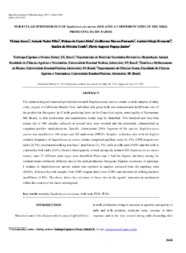Molecular epidemiology of Staphylococcus aureus isolates at different sites in the milk producing dairy farms.
Molecular epidemiology of Staphylococcus aureus isolates at different sites in the milk producing dairy farms.
Autoria: SOUZA, V. de
Resumo: Abstract: The epidemiological relationships between isolated Staphylococcus aureus strains in milk samples of dairy cows, reagent to California Mastitis Test, individual and group milk was demonstrated in different sites of the production fluxogram, in 12 milk-producing farms in the Gameleira region, municipality of Sacramento MG Brazil, so that localization and transmission modes may be identified. Two hundred and forty-four strains out of 446 samples collected at several sites were isolated and bio-chemically characterized as coagulase-positive staphylococcus. Specific chromosome DNA fragment of the species Staphylococcus aureus was amplified to 106 strains and 103 underwent (PFGE). Samples? collection sites with the highest isolation frequency of Staphylococcus aureus strains comprised papillary ostia (31.1%), CMT-reagent cow milk (21.7%), mechanical milking machines? insufflators (21,7%), milk in milk pails (6.6%) and the milk in community bulk tanks (5.6%). Genetic heterogeneity existed among the isolated 103 Staphylococcus aureus strains, since 32 different pulse-types were identified. Pulse-type 1 had the highest similarity among the isolated strains within the different sites of the milk-production fluxogram. Highest occurrence of pulsetype 1 isolates of Staphylococcus aureus strains was reported in samples collected from the papillary ostia (10.6%), followed by milk samples from CMT-reagent dairy cows (5.8%) and mechanical milking machine insufflators (3.8%). The above shows the relevance of these sites in the agents? transmission mechanism within the context of the farms investigated.
Ano de publicação: 2012
Tipo de publicação: Artigo de periódico
Unidade: Embrapa Caprinos e Ovinos
Palavras-chave: Brasil, Bulk tank, Doença animal, Mamite, Minas Gerais, PCR, PFGE, Staphylococcus aureus, Vaca leiteira
Observações
1 - Por padrão são exibidas publicações dos últimos 20 anos. Para encontrar publicações mais antigas, configure o filtro ano de publicação, colocando o ano a partir do qual você deseja encontrar publicações. O filtro está na coluna da esquerda na busca acima.
2 - Para ler algumas publicações da Embrapa (apenas as que estão em formato ePub), é necessário ter, no celular ou computador, um desses softwares gratuitos. Sistemas Android: Google Play Livros; IOS: iBooks; Windows e Linux: software Calibre.
Acesse outras publicações
Acesse a Base de Dados da Pesquisa Agropecuária (BDPA) para consultar o acervo completo das bibliotecas da Embrapa.

